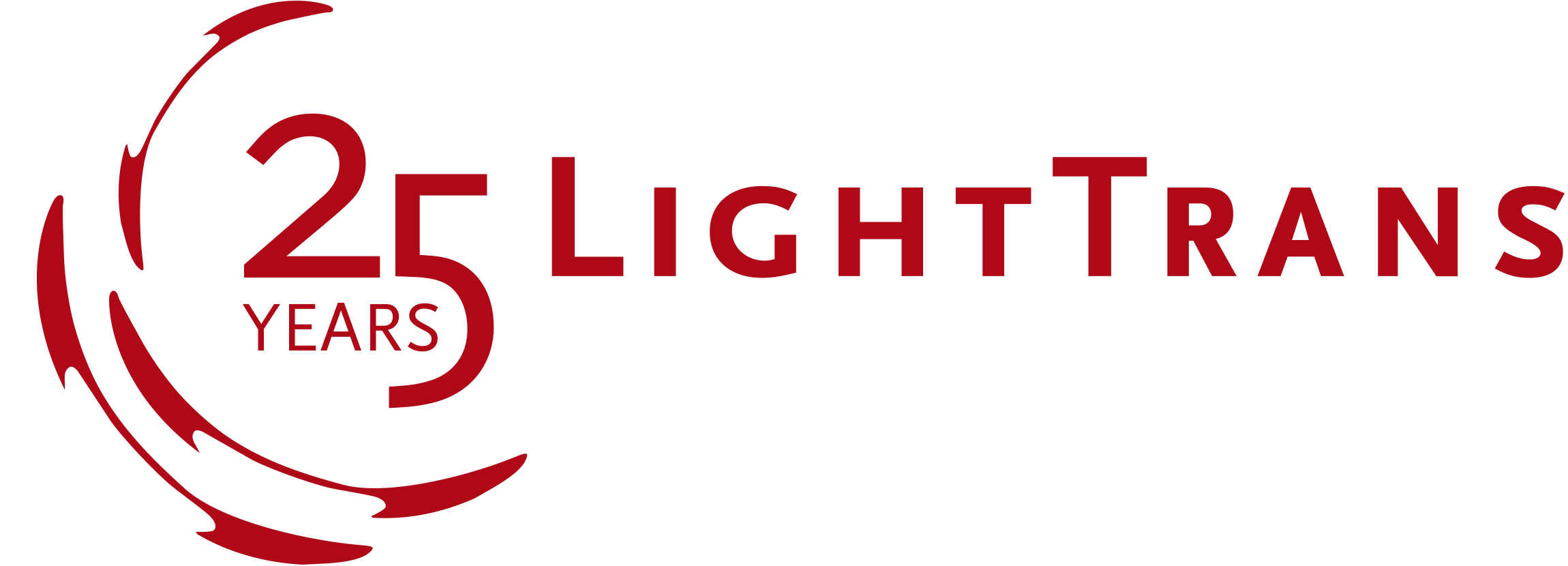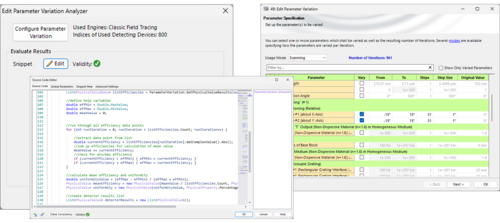What’s new in our Optical Modeling and Design Software?
Robustness Analysis and Optimization of Grating Setups
Gratings are a fundamental tool in the arsenal of many optical engineers, since their physical properties (of diffracting incident light into a set of discrete orders) make them a very attractive tool in many different configurations and for many different applications. It is then of major interest to investigate how well a given grating setup can tolerate small deviations from the design parameters, created by e.g. manufacturing processes. Please take a look at the documents below to find an example in which we optimized a slanted grating to be resistant against variations in its fill factor. We achieved this using the newly released Parameter Variation Analyzer to perform a tolerance analysis of the setup and calculate a merit function that averages the efficiency of the working order for different fill factors.
But the parameters of the grating itself are not the only thing which can influence performance in this kind of system: most periodic structures with small feature sizes are known to be strongly sensitive to the polarization state of incident light. As the second use case for this week, we have selected a scenario in which the polarization dependency of a binary grating is analyzed, and the structure is optimized to perform well under incident light with arbitrary polarization angles.
Game-Changing Acceleration of Your Simulation With Distributed Computing!
VirtualLab Fusion now comes with the revolutionary Distributed Computing technology that allows you to tremendously speed up your simulations. To demonstrate the power of this new technology we have prepared two examples which you can find in the documents linked below. In the first one, we investigate the performance of a waveguide device by performing a parameter sweep over 101 x 101 field-of-view angles, resulting in a total of 10201 elementary simulations. With Distributed Computing, these simulations can be performed in parallel on different machines in a network, leading, in our specific example, to a 91% reduction in calculation time.
As a second example we have prepared a coherence measurement using a white-light interferometer. There, multiple wavelengths as well as a shift in one of the interferometer arms lead to a total number of 2904 simulations. Through the application of Distributed Computing we can reduce the simulation time from almost one hour to barely 3 minutes.
These examples demonstrate the game-changing reductions in simulation times which can be achieved with the new Distributed Computing Package. Take a look at the examples linked below and see for yourself!
Field Inside Analyzer for 2D Gratings
With the latest release of the optical modeling and design software VirtualLab Fusion, version 2023.2, a number of new and helpful tools have been added. But the novelty does not stop there: we have also taken this chance to upgrade some of our previously existing features. In this week’s newsletter we put the spotlight on the Field Inside Component: FMM analyzer, a tool that allows the user visualize and investigate the field distribution inside micro- and nanostructures. The analyzer can now also analyze 2D-periodic structures.
Please take a look at the documents below to find an introduction to the Field Inside Component: FMM analyzer as well as an example where we investigate (and go on to optimize) the reflectivity of an anti-reflection moth-eye structure.
VirtualLab Fusion 2023.2 – Easier Use, Better Control in Data Visualization!
While the Distributed Computing Package and the Parameter Variation Analyzer certainly are the highlights of the latest release of the optical modeling and design software VirtualLab Fusion, 2023.2, we have also implemented a whole set of new features and improvements for our result and data visualization, allowing the user a clearer picture of what is going on in the optical system.
Hence, in this week’s newsletter we want to put the spotlight on two of these additions. Please take a look at the documents linked below to find a guide to our Ray-Results 3D System View, the perfect engine to provide a quick overview of how the system is set up and what the light propagation inside it looks like. With this latest release, we have added options to, for instance, filter out any rays that do not pass a specific aperture, as well as new ruler to easily measure distances in the view. The second document tells you all you need to know about how regions work in VirtualLab Fusion, including the multiple new tools to scale, rotate and shift regions.
Parameter Variation Analyzer
Multiplexing is a cornerstone of optical design: whether the task is to come up with a setup which can perform its intended function well under different conditions (for example, an augmented-reality device which must work for a certain field of view), or to carry out a tolerance analysis of a given design, it is often desirable to calculate a single merit function which encompasses multiple different configurations of the same system. This helps us characterize the behavior of said system over a certain parameter range with a single measure.
For exactly this purpose, VirtualLab Fusion’s brand-new release 2023.2 introduces the Parameter Variation Analyzer. This flexible and powerful tool offers the capability to process the results of multiple detectors and/or multiple iterations from e.g. a parameter sweep into a freely customizable result, which can then be employed as the merit function of an optimization, for instance.
In the documents below we have prepared for you a deep-dive document into this new feature as well as an application example in the form of a CIGS (copper indium gallium selenide) solar-cell. In this example we use the Parameter Variation Analyzer to combine the values from 4 detectors and finally calculate the energy absorbed in the CIGS layer.
As Accurate as Needed, as Fast as Possible: New VirtualLab Fusion 2023.2!
We are proud to announce the release of the latest version of the optical modeling and design software VirtualLab Fusion, 2023.2!
The signature technology of VirtualLab Fusion is its interoperability of modeling techniques on a single software platform, which allows you to have full control of the balance between accuracy and speed that is always an unavoidable aspect of simulation technology. Version 2023.2 expands on this concept, pursuing the development goals we have set ourselves to offer ever higher speed, easier use, more physics, deeper transparency, and more control.
Distributed Computing
The new release of VirtualLab Fusion – version 2023.2 – is here, and with it come exciting new features. One of the most important, which we would like to highlight in this week’s newsletter, is the Distributed Computing Package.
This tool is aimed at drastically improving simulation times for those complex problems which are composed of multiple elementary simulations, such as parameter sweeps or tolerance analysis. The Distributed Computing Package makes it possible to allocate the individual elementary tasks to different machines (computers/servers) in a network, so that they are calculated in parallel, thus decreasing overall simulation time.
Please take a look at the documents below for a deep dive into the new technology, as well as an application scenario where we drastically improve simulation times for a white-light interferometer example.
Diffractive Lenses for Medical Applications
Hybrid lenses combine the advantages of classic refractive components and diffractive structures, and hence have become a promising approach in different optical applications, such as intraocular lens implants for treatment of cataracts. In particular, the opposite signs of the dispersion for refractive and diffractive surfaces enable the correction of chromatic aberrations.
In order to model and design such a hybrid element accurately, the in-depth analysis of diffraction effects through the system is a necessity. This includes the evaluation of diffraction efficiencies of real structures in combination with the fast and accurate calculation of the point-spread function (PSF). VirtualLab Fusion’s highly flexible approach of interoperable modeling techniques on a single platform is key to enable the precise and quick modeling of classic lenses and calculation of the diffraction efficiencies of the different orders of a diffractive lens.
To illustrate the capabilities of the software in this regard, the near and far field view of a designed hybrid lens are analyzed in the example. Moreover, the effect of varying the height of the designed binary element on the diffraction efficiencies is investigated to further optimize the optical function. In order to evaluate the resulting PSFs similar to the perception of a human eye, photometric quantities, such as illuminance and luminous flux, are used, which can easily be determined with the help of VirtualLab’s flexible detector concept.












